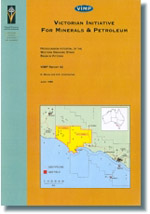VIMP Report 62 - Hydrocarbon potential of the western onshore Otway Basin in Victoria
 |
| |||||
Product description:Download The downloadable version of this report is supplied in PDF format. Executive Summary The Victorian Government is inviting applications for two onshore exploration areas in the Otway Basin. The two blocks, called VIC/O99(1) and VIC/O99(2), are located at the western end of the Victorian part of the basin next to the South Australian border. The eastern block, VIC/O99(1), covers an area of 3212 km˛; and the western block, VIC/O99(2), an area of 1718 km˛. The two blocks are located approximately 350 kilometres WSW of the cities of Melbourne (pop 3,370,000) and Geelong (pop 153,000), with the largest local population centre, the port city of Portland (pop 9,600), located in the southwestern corner of VIC/O99(1). Applications for these blocks close October 14th 1999. Geologically, the area covered by this report is underlain by a NW-SE striking Late Jurassic - Early Cretaceous rift system; the southwestern half of which is overprinted by a NW-SE striking Late Cretaceous rift system that is in turn overprinted by a NW-SE striking Latest Cretaceous - Early Tertiary trough (Portland Trough). Nineteen petroleum exploration wells and stratigraphic wells have so far been drilled in the two gazettal blocks: eight in VIC/O99(1) and eleven in VIC/O99(2). The first five were drilled between 1925 and 1945; four by private companies and one by the State Government. The other fourteen wells were drilled during the last twenty-five years: one in 1974 by Shell, one in 1981 by the Geological Survey of Victoria, eight by Beach Petroleum between 1983 and 1987, another by the Geological Survey of Victoria in 1990, two by Gas & Fuel Exploration in 1990 and 1991, and one in 1995 by GFE Resources. Although no commercial accumulations of hydrocarbons have yet been found in the report area, numerous oil and gas shows have been observed in both blocks, the most significant being Lindon 1 which intersected a 3 m oil column. Lack of success in this area is largely due to poor seismic control, with much of the data collected by Frome-Broken Hill (a Mobil/BHP Petroleum joint venture) and Shell in the late 50’s - early 70’s, and Beach Petroleum in the 80’s, being of poor quality. Consequently, most of the wells were drilled off structure, or on leads which are now considered not prospective. Examination of vitrinite reflectance and geochemistry data indicates three petroleum systems are active in the report area. These are (in ascending stratigraphic order) the:
Potential play fairways include (in ascending stratigraphic order):
Potential play fairways in the Portland Trough include the base Late Cretaceous Waarre Formation and base-Tertiary Pebble Point Formation. The former possibly has the best reservoir potential of the two, as it is already a proven reservoir in the Port Campbell area. The underlying Otway Group play fairways (i.e. the Casterton Formation, Pretty Hill Formation, Katnook Sandstone, Windermere Sandstone Member and Heathfield Sandstone), on the other hand, are probably too deep to be viable reservoirs. Charge for the Waarre and Pebble Point plays would most likely be from the Eumeralla Formation, which in the Portland Trough, is overlain by 3000 - 3500 m of Late Cretaceous - Tertiary sediments; the optimum thickness for Tertiary hydrocarbon generation. Potential play fairways in the southwest part of the Northern Platform include the Pretty Hill Formation, Katnook Sandstone, Windermere Sandstone Member, Heathfield Sandstone Member, Waarre Formation and Pebble Point Formation. In this area, the Late Cretaceous – Tertiary section ranges from 500 to 2000 m in thickness and is thick enough to have pushed those parts of the Eumeralla Formation not affected by the Early Cretaceous thermal event into the oil window during the Tertiary. Again, the potential for oil generation is good, but the most likely product is gas. Potential play fairways in the northeast part of the Northern Platform include the Casterton Formation, Pretty Hill Formation, Katnook Sandstone, Windermere Sandstone Member and Heathfield Sandstone Member. In this region, the Late Cretaceous - Tertiary sequence is < 500 m thick and is too thin to have generated hydrocarbons from the Eumeralla Formation in the Tertiary. Consequently, any charge in this area would most likely be from the Casterton Formation and Pretty Hill Formation, with expulsion occurring in the Early Cretaceous. Again, gas is the most likely product. In summary, the area covered in this report still has significant hydrocarbon potential despite the lack of success so far. This potential is further enhanced by the close proximity of the area to the Victorian gas market. Presently, approximately 200 km of gas pipeline network exists across the Victorian part of the Otway Basin. The gas is sourced from the Port Campbell gas fields and supplies Cobden, Warrnambool, Hamilton and Portland. An additional 130 km of gas pipeline has also just been constructed in order to expand the network back to Colac, Winchelsea and Lara. Bibliographic reference Mehin, K. & Constantine, A.E., 1999. Hydrocarbon potential of the western onshore Otway Basin in Victoria. Victorian Initiative for Minerals and Petroleum Report 62. Department of Natural Resources and Environment. | ||||||

